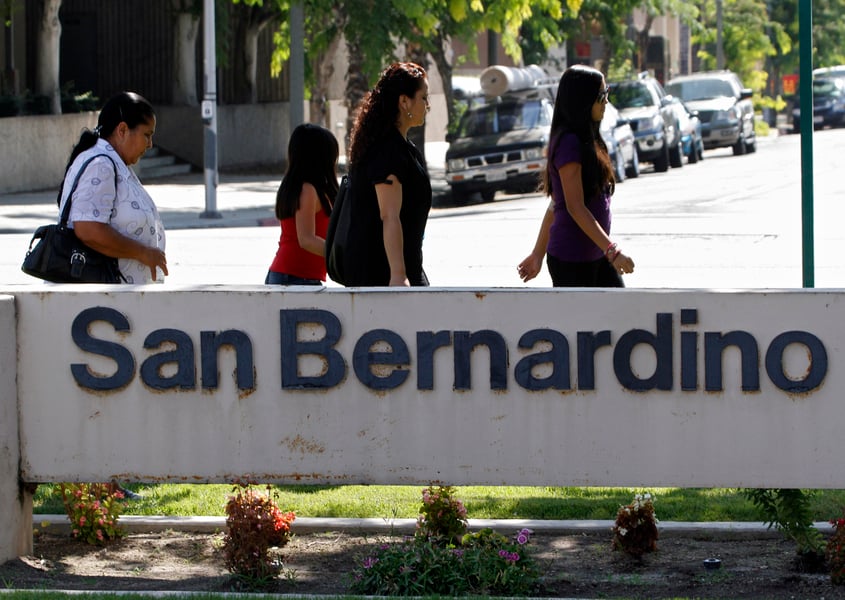San Bernardino is the third municipality in California to face tough choices about how to deal with its balance sheet ... and it might not be the last
As the city of San Bernardino, Calif., teeters on the edge of bankruptcy, some are seeing the glass as being half empty while other are seeing the glass as three-quarters empty.
“In the state of California, you're going to see a lot more municipalities file for Chapter 9 bankruptcy because they simply don't have a choice,” said Brian Amidei, a managing director and partner with HighTower Advisors LLC.
Mr. Amidei, who advises on $700 million in client assets from his office in Palm Desert, Calif., compared the overall California economy to the year-end fiscal cliff facing the U.S. economy.
“In a lot of municipalities, the employee benefit costs are too high, entitlement costs are too high, pension costs are too high, and the state of California has cut funding for them,” he said. “It's a very precarious situation, much like the fiscal cliff.”
San Bernardino, a city of 209,000 about 65 miles east of Los Angeles, has taken a step toward becoming the third California town in less than a month to file for bankruptcy protection.
Stockton filed for court protection June 28, followed by Mammoth Lakes July 3.
The San Bernardino city council voted Wednesday in favor of filing for Chapter 9 protection.
Despite the recent string of bankruptcies, preceded earlier this week by a decision by the mayor of Scranton, Pa., to cut all municipal employee salaries to minimum wage to try and balance the books, not everyone sees the same level of despair.
“We may have a few more of these happen, but the main point is the municipalities need access to capital, and they know if they default on their bonds, they won't get that,” said J. Brent Burns, president of Asset Dedication LLC, which builds fixed-income separate accounts.
“What Stockton did will probably not help their cause, but it's important to remember that they chose to default on bonds that have insurance,” he said. “They know they have to make sure investors get paid and everyone is made whole because [bond issuance] is the only source of income they have for big projects.”
In addition to dissecting the minutiae of the latest muni bankruptcies, Mr. Burns pointed out that in the case of San Bernardino, fraud was a major culprit.
“It looks like 13 of the last 16 years of financial documents have been doctored because they were cooking the books,” he said. “For sure, people will lose their jobs, and I suspect some will go to jail.”
According to Bloomberg, San Bernardino is facing insolvency amidst a $45 million budget shortfall because of accounting errors, deficit spending, pension and debt costs, and a lack of revenue growth.
Over the past four years, government officials have declared fiscal emergencies, negotiated for concessions from employees and reduced the workforce by 20%.
“It's starting to come out that there was some funny accounting going back several years,” said Dan Heckman, senior fixed-income strategist with US Bancorp.
He added that the “double whammy” was the combination of high housing foreclosure rates, a high unemployment rate and expensive employee benefit packages that “make up a poisonous cocktail.”
Mr. Heckman said it is not unusual for a municipality to face fiscal challenges, but he doesn't believe bankruptcy is the answer.
“We're three years into the recovery from the financial crisis, and they are just now trying to get ahead of their problems,” he said. “Chapter 9 bankruptcy can be incredibly expensive and it adds another stigma to the situation. In the long run, the muni market is going to punish you.”
Mr. Burns said it would be a mistake to assume California, or the country as a whole, is poised for a flood of municipal bankruptcies.
“Municipalities have an incentive not to default on their loans,” he said.
While the incentive to avoid default might be there, Mr. Heckman worries that other municipalities might start viewing bankruptcy as an easy way out.
“What I'm concerned about is some of the other really challenged metro areas of California,” he said. “As some of these municipalities sneeze, do we start to see other municipalities catch a cold? And then, six months to a year from now, I'm concerned that these municipalities that filed Chapter 9 are going to realize that they didn't solve all their problems.”
Tom Dalpiaz, who manages $310 million worth of muni bond portfolios for Advisors Asset Management, also cautioned that the San Bernardino situation should be kept in perspective.
“We've known for some time that California cities are having a tough go of it,” he said. “As a portfolio manager, you hate to see this kind of stuff, but it is absolutely not the beginning of the breaking of the floodgates.”
Of the 55,000 issuers of muni bonds, only about a half dozen have gotten close to defaulting, Mr. Dalpiaz noted.
“That's not a flood,” he said. “When these things happen, it's very rare, and that's why it makes the news.”
Despite what he called a “steady drip of entities that feel like they have no other choice,” Mr. Dalpiaz said the number of muni defaults is down from last year and revenues are up.
“My sense is that pension reform is occurring and the tough problems are being dealt with, but there are still some cities at various places on the curve of difficulty,” he said. “This should tell you that the vast majority of the market is fine, but you have to be vigilant.”







